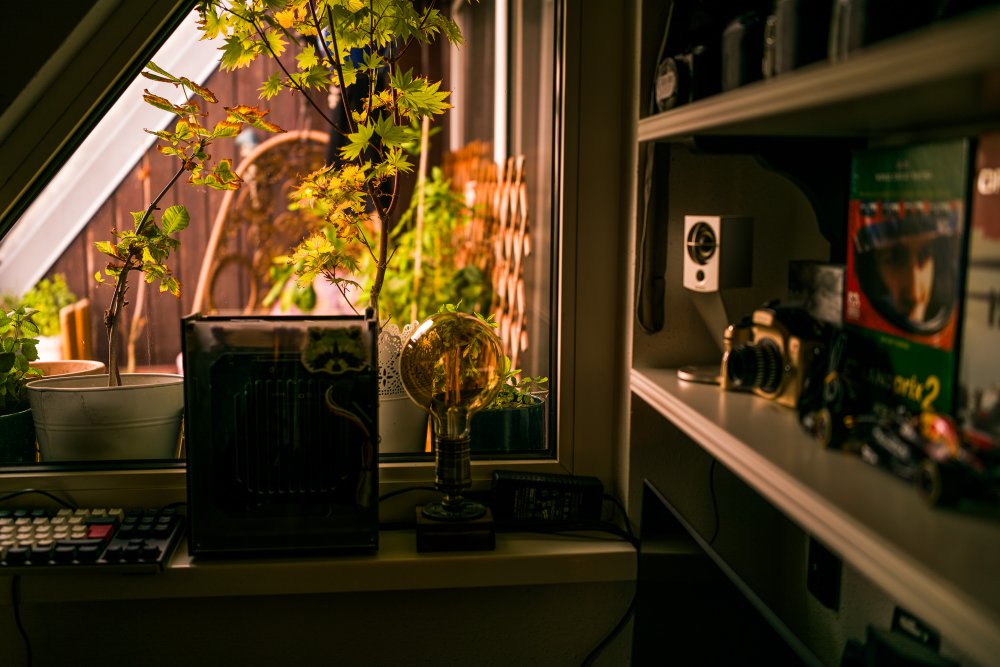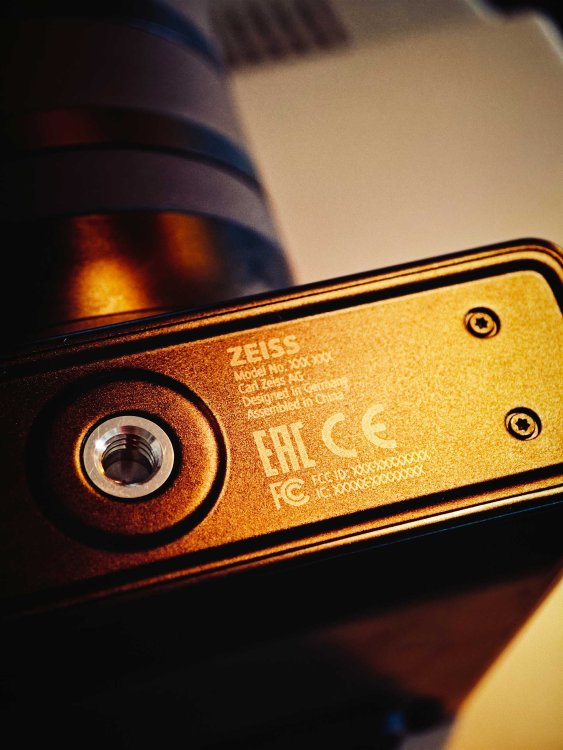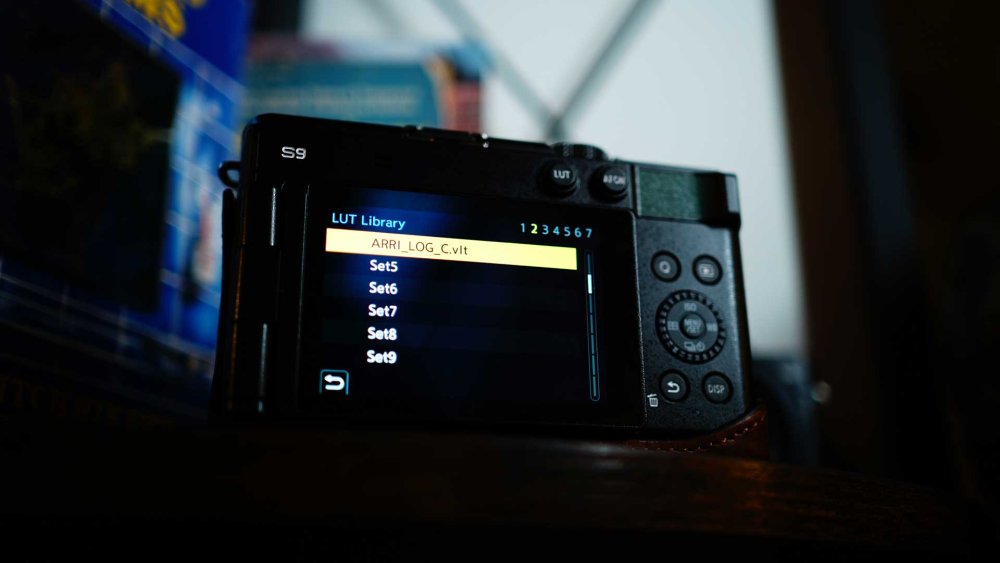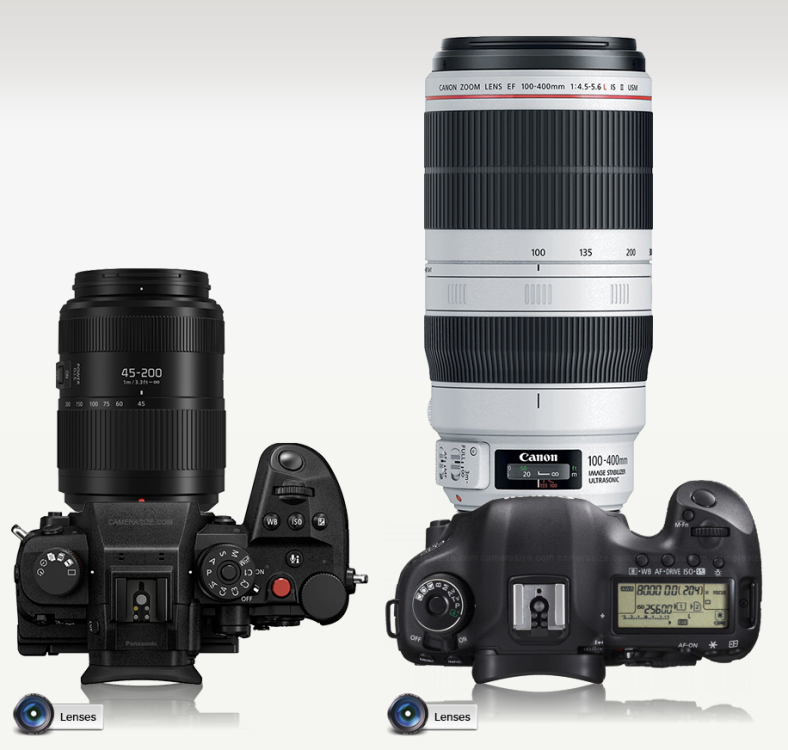All Activity
- Past hour
-
I deliver in 4K too. Just upscale your 1080p project to 4K on export - no-one can tell the difference! Wow - 35-350mm.... now THAT is a lens! That's definitely a lot, and I can understand why you'd feel a bit entitled too, after paying so much. If you're likely to see some animals while you're travelling around seeing other sites then that's probably the best way, as the animals you do see will seem like good fortune rather than focusing on the animals you paid to see and didn't. Those other places seem really cool too. Africa seems like a strange continent in many ways. Of course, in lots of those ways it's quite like the remote places here in Australia, but although I've seen quite a number of them they still seem strange.
- Today
-
 kye reacted to a post in a topic:
The YouTubers are fighting!
kye reacted to a post in a topic:
The YouTubers are fighting!
- Yesterday
-
 ArashM reacted to a post in a topic:
Zeiss ZX1 full frame Android prototype, let's repair
ArashM reacted to a post in a topic:
Zeiss ZX1 full frame Android prototype, let's repair
-
 Andrew Reid reacted to a post in a topic:
Zeiss ZX1 full frame Android prototype, let's repair
Andrew Reid reacted to a post in a topic:
Zeiss ZX1 full frame Android prototype, let's repair
-

Zeiss ZX1 full frame Android prototype, let's repair
MrSMW replied to Andrew Reid's topic in Cameras
MPB 😂 -

Zeiss ZX1 full frame Android prototype, let's repair
Andrew Reid replied to Andrew Reid's topic in Cameras
I got it from the resident Berlin Leica Thief. -
 PannySVHS reacted to a post in a topic:
Zeiss ZX1 full frame Android prototype, let's repair
PannySVHS reacted to a post in a topic:
Zeiss ZX1 full frame Android prototype, let's repair
-
Zeiss ZX1 full frame Android prototype, let's repair
PannySVHS replied to Andrew Reid's topic in Cameras
Hot stuff. Where did you acquire this novelty camera? That must be the youtube camera video of the year! Only thrills, no shills, a perfect watch with chips, soda and chills! @Andrew Reid -
 FHDcrew reacted to a post in a topic:
The YouTubers are fighting!
FHDcrew reacted to a post in a topic:
The YouTubers are fighting!
-
 PannySVHS reacted to a post in a topic:
Zeiss ZX1 full frame Android prototype, let's repair
PannySVHS reacted to a post in a topic:
Zeiss ZX1 full frame Android prototype, let's repair
-
 PannySVHS reacted to a post in a topic:
Zeiss ZX1 full frame Android prototype, let's repair
PannySVHS reacted to a post in a topic:
Zeiss ZX1 full frame Android prototype, let's repair
-
 PannySVHS reacted to a post in a topic:
Panasonic Firmware Update For S1II/S1IIE/S1RII Includes ARRI LogC3 Option
PannySVHS reacted to a post in a topic:
Panasonic Firmware Update For S1II/S1IIE/S1RII Includes ARRI LogC3 Option
-
 PannySVHS reacted to a post in a topic:
Panasonic Firmware Update For S1II/S1IIE/S1RII Includes ARRI LogC3 Option
PannySVHS reacted to a post in a topic:
Panasonic Firmware Update For S1II/S1IIE/S1RII Includes ARRI LogC3 Option
-
Youtubers are snoring! Better quit watching, cuz it's so boring!
-
For what it's worth, so far, I have to say that my experience has been very positive. I've bought lenses and cameras without hiccups. I've sold about 5000 euros of gear to them and most of the time they upped my initial quote. A key part of that process is they don't report the amounts they pay me to the French government either as it must be some loophole, unlike when you sell on leboncoin.fr. The process is a little slow, but I don't have the same headaches about wondering if I'm going to get paid or scammed. If they don't accept my condition for an item, they just send it back to me. I'm happy.
-

Zeiss ZX1 full frame Android prototype, let's repair
Andrew Reid replied to Andrew Reid's topic in Cameras
The book is highly recommended 🙂 Or as they call them in the Netherlands... Booooooooooooooooooooooooooooek -

Zeiss ZX1 full frame Android prototype, let's repair
Andrew Reid replied to Andrew Reid's topic in Cameras
Does Android 6 have Camera API 2.0? I'll try it out -

Zeiss ZX1 full frame Android prototype, let's repair
MrSMW replied to Andrew Reid's topic in Cameras
Is that you Mr Bond? -

Zeiss ZX1 full frame Android prototype, let's repair
MrSMW replied to Andrew Reid's topic in Cameras
Ah, the old 'Irish Screwdriver' technique. Always works. Except when it doesn't. I liked the concept of this camera, but never dared... -

Zeiss ZX1 full frame Android prototype, let's repair
BTM_Pix replied to Andrew Reid's topic in Cameras
Or a full frame 36 megapickshel shensor as its known there. -
Zeiss ZX1 full frame Android prototype, let's repair
FHDcrew replied to Andrew Reid's topic in Cameras
Imagine if MotionCam RAW worked on this… -
Nice is doing a lot of heavy lifting there. But if people don't mind log shots of mainly grey buildings under grey skies in Salford then have at it !
-
It's true - though if they made that lens and it had decent quality, I might be one of the only people who would be excited to get it as soon as it hit the second-hand market. It's true - when on set, I'm usually shooting my t/1.2-t/2 lenses at closer to t/2.8-4, partly because getting the subject in focus is better than having a razor-thin focus plane. I tend to like to deliver in 4k, but yes, post-cropping flexibility is the main reason that I usually capture in 6k or 8k for narrative. I also like wider aspect ratios (even in film, where I like 6x17, 4x10, and 8x20 the most) so even shooting 4k gives some room to reframe up or down a little bit. I used to have the EF 24-105/4 and I never liked it much, but I have the 24-70/2.8 and it's fantastic. It could certainly be an option. I've also, at various points in my life, considered the Canon 35-350/3.5-5.6L - still a fairly large lens, but it's a 10x zoom for FF that manages quality a bit nicer than a coke bottle. It's pretty affordable used these days. But I'm more likely to try to stick with things I already have. Guided safaris are extremely expensive from what I've seen. It's potentially good advice, but I prefer that we go our own way. There's always the possibility of seeing one of the guided tour buses rolling around and following it for a bit too. Plus, if I gave somebody $1,000-2,000/day to show us the animals, I'd probably mentally feel a bit entitled when seeing them. If we go on our own and I see a single giraffe head snacking on a tree, I'll be beside myself with excitement. Plus we can research before arriving to see if there are sites listing the most likely places. I also am focusing on the time in Etosha, but it's also going to be 2-3 days of a 2-week trip. I'm also really excited to see some of the shipwrecks along the skeleton coast, the dune-filled houses of Kolmanskop, the huge sand dune fields of Sossusvlei, and to take my own version of the iconic field of dead trees in front of an orange dune at Deadvlei... (among other things)... and from what I've read, random wildlife encounters (zebras, etc) are pretty likely when driving around a lot of the countryside.
-
A very good move with the stacking of adapters for E. That adapter at $150 is $100 less than the Megadap one too.
-
According to a book, Dutch company ASML got into a big fight with Nikon a few years back. They both make lithography tools for semiconductors industry. ASML's optics supplier is Zeiss. To pressure Nikon into a settlement, they had to take the patent fight to them in cameras. So ASML got Zeiss to make them a camera. It also doubled as a marketing adventure, shown off in stores but rarely really ever in stock. Until one day this popped up on my radar, with the serial number XXX XXX. The AF wasn't working, or the manual focus (fly by wire), lens stuck at macro 30cm. So I cracked it open, mopping sweat off forehead. Inside is 256GB SSD, final release model was bumped to 512GB. Android 6, with Zeiss test suite of apps onboard including FCC certification test suite 🙂 A music player. A Dutch full frame 36 megapixel sensor with some analogue colour. A Zeiss 35mm F2 lens (but different optics to the Sony RX1), 4K video (Super 35mm crop) and an EVF. And some weird prototype issues. I'll make a YouTube video on it. Sample shot And I still have no idea how I fixed the AF. Just wiggled the lens and sensor ribbon cables a bit and it started working properly, but there was no sign of either cable being loose in the first place! It is quite a fun tool, and a bit different. Android is decently snappy on it, the camera app is well designed, the physical dials are lovely but it doesn't have a joystick or command dials... So a lot is on the touch screen, but it's well done. Shall I root it? Update to 3.0 production firmware? (Risks bricking it). Given the rarity factor... I probably won't!!
-
How I would love to see uncompressed 14bit Cinema DNG on newer Canon. Perhaps the R7, would be a perfect candidate. Let's hope they focus efforts on supporting the stuff beyond the DSLRs and older EOS M 👍
-

Panasonic Firmware Update For S1II/S1IIE/S1RII Includes ARRI LogC3 Option
Andrew Reid replied to BTM_Pix's topic in Cameras
Might be time to release my version for free then! The download link will self destruct in 48 hours. Until then... enjoy! https://drive.google.com/file/d/1Z60UNsWHuc6wFmgEOlp0VgDlucHoutip/view?usp=share_link Works on Panasonic S9, S5 II, GH7 as well as all the new cameras. I'd welcome any questions, feedback, help making a guide for regular folk, or even comparisons to the official ARRI LOG profile, or even the odd ALEXA. Sample shots also welcome!! @BTM_Pixhas shot some nice stuff with it already. If you're ok for me to share it? And the ARRI LUT library is available here https://www.arri.com/en/learn-help/learn-help-camera-system/tools/arri-look-library-app Installation is via SD card as a real-time LUT so it sits in-camera, next to V-LOG and the regular picture styles. -
Yes, even though electronic music has been around for decades ppl still play guitars, flutes and bang drums like they have done for 50,000 years or more. Think of all the mediocre electronica outfits out there vs the ones who get it right. Objectively, even a mediocre guitarists is better than a mediocre electronica artist just bc the way he expresses his artistic intention. The exact same thing will happen with AI. Of all the trillions of Terabytes done with this tech only 0.1% will rise to the surface and have any merit.
-
Exactly the current info is a mess with half of YT saying it’s the same as a simple CST while the other half (shills) are like “omg your LUMIX s1 II is a baby Alexa and and and it’s different cuz cuz cuz arri engineers tweaked the color look look but my affiliate LUMIX sent me this camera for free”
-
Panasonic Firmware Update For S1II/S1IIE/S1RII Includes ARRI LogC3 Option
newfoundmass replied to BTM_Pix's topic in Cameras
I think it's pretty incredible that a small mirrorless camera has gotten this BUT I take nothing said about it so far seriously because the only people who seemingly have access to it are shills (and while I like watching some of them, they are still shills.) It'll definitely be interesting once real users get their hands on it and try it out, but until then its just a "oh, that could be really neat." I am, however, intrigued by the possibility of more Lumix/Arri collabs and what the future might hold if they are working together. -
Equivalency of DOF is the elephant in the room for sure. In comparison, MFT lacks in the selection of gargantuan lenses with super-shallow DOF and FF lacks in small lenses without shallow DOF. If someone made a FF 28-280mm F7.0-11 lens then it should be the same size as my 14-140mm F3.5-5.6 lens, but of course the internet would go ballistic over it and run whatever manufacturer dared to create such an abomination out of town faster than you can say "grab your pitchforks - the devil has come for our children!". It depends on what you're doing of course, but for me personally when I switched from watching YT lens reviews to watching award winning movies and TV shows from the worlds leading professionals I had the Ah-ha moment when I realised very few shots had shallower DOF than could be achieved with relatively normal MFT lenses. Even when looking at the shots that would have required quite fast lenses on MFT, the aesthetic penalty for the DOF being deeper was very low. I then looked at what potential benefits would be traded-away for it.... lighter cameras that make me more likely to carry them around and use them and therefore get more shots to use in the edit... smaller equipment making me more pleasant to be around and having a nicer trip and causing the people around me to be happier and more relaxed and look nicer in frame... the smaller rig making the people around me less distracted and suspicious... the deeper DOF meaning there was less chance of having one person in focus but the others out of focus or it simply missing focus by focusing on the wrong thing... the much lower likelihood of having a difficult conversation with law enforcement or self-important security staff, etc. I concluded that getting slightly shallower DOF was a very small benefit competing against a significant number of advantages that would make far more impact to the end product and to my experience in using it. The extra cropping potential is one of the only benefits I can see for sensors above 2.5K. I put the cropping modes on my GH5 and GX85 into good use when I was shooting on primes and have been hugely impressed with them with my GH7 + 9mm F1.7 PanaLeica which I'll use for shooting in ultra-low-light. The R5 + EF-RF + 40mm F2.8 would be a great medium size setup. Perhaps the best second camera FF setup I could think of would be your R5 + 24-105mm F4. Like I mentioned above, the flexibility and speed of using a zoom when shooting in uncontrolled conditions just gives you more coverage - there's a reason doco and ENG shooters use zooms! Yeah, that's a real gem, I'm still seeing footage crop up on YT that really shows how much you can push things. I've also noticed it's very popular with the vlogging crowd and it seems to give really good results, similar to those who might use a small mirrorless, which is definitely saying something when you consider the size of it. Nah. Do a complete end-to-end analysis of what gives you the best results in the final edit or final photos, work out what equipment aligns best with those trade-offs, buy it, test it and learn the settings, then shift focus to actually shooting and don't look back. Beauty magazines make you feel ugly, and camera YT makes you regret your equipment. Best strategy is to ignore both. By far the most important skill in uncontrolled environments is being able to understand and predict the behaviour of your subjects. Not only does this matter for shooting people in public, but it matters doubly (triply?) for safari because the biggest struggle seems to be even finding the animals in the first place. A professional animal tracker would probably get better footage with an iPhone than an amateur with all the equipment in the world who spent a week and only saw a few animals the whole time. Perhaps a good exercise is to think about what the total cost will be of the trip, think about how much it would matter if you didn't see any animals at all, and then see how much it would cost to hire a guide or some other service that would help you locate things. There's a reason that people hire a model instead of just walking the streets hoping to find someone to shoot!
-
Truth. Though by the time you make an MFT lens with equivalent DOF to a FF lens with the same FOV, it ends up around the same size. It's one of the reasons the Canon 800/11 is (relatively) small, as are mirror lenses. Not that DOF matters much for wildlife in the distance. I'll also keep in mind that I can get away with fewer lenses because 100 megapixels is a lot and because I can vary between 4k and 5.8k that are 44mm wide and 8k that's 36mm wide - that's a lot of focal lengths for each lens, assuming that the lenses resolve well. The relatively tiny Fuji GF 50/3.5 is kind of amazing for that reason. Of course, there are plenty of tiny FF lenses too - the Summicron-M's are small and something like the Canon 40/2.8 is fantastic. I could just bring my R5 with that, I suppose. Or I could just bring the Osmo Pocket 3 and call it good. Some of my favorite photos from Peru were taken with it! It's also really easy to keep handy in a pocket or I could probably hang it from a little carabiner on a belt loop or something like that. You're gonna make me regret selling all of my MFT gear a few years ago. 😢 (I regretted it almost immediately, though I can make myself feel a bit better when I realize I wouldn't be using it most of the time) I haven't looked much into that - I know that late September is a considered a good time to go, partly because it's before a lot of the rains come in and I'm told that it's easier to find animals near watering holes. I have no illusion that anything I do will be an award-winning photo, in any case. Heat waves or no, I'm sure the photos will make me happy as long as I can make out the animals.
-
Yes, AI is a real wildcard. I see that there are really three fundamentally different groups when it comes to generative content. The first is professionals who create material for the general public, or various niches of the public. This is where AI will have incredible impacts. The second is professionals who create for their clients directly. This is people like wedding photographers etc, where the client is the audience. This has been debated, but I think that there will still be a market here. If I did something and wanted a record of it, I would want the final images to be of me, not AI generated content that looks like the people I know might have looked during the thing that actually happened. The third is people creating for themselves, where there is no client or money changing hands. This is every amateur, every personal project from professionals, etc. The goal is to have a final result that this person created. Amateur photographers take photos and print and hang the best ones, not because they're the best photos ever taken, but because they were taken themselves. Personally, I'm in the last category and I am completely resigned to the fact that my videos will never be great, will never attract a significant audience, will never be regarded as important, etc, but that's not why I do it so in that sense AI is no threat to me at all. I do understand that people are all in different segments of the industry and have very different perspectives for very good reasons..
-
A phone is always a great second camera in a pinch.. but if there's budget, it's hard to look past the GX85 or LX10. They're comparatively small, especially if you fit the GX85 with one of the pancake zoom lenses. Jeez, it's lenses the whole way isn't it. A sensor size goes up, lens size goes up exponentially... Maybe you should rent an MFT system? I understand that lots of the wildlife is best seen at dawn? Things can be pretty still then, so that works in your favour. Not sure how things go at dusk as the sun shouldn't have been heating things directly for a while and temps could even out a bit. But if you're shooting big cats sitting lazily in trees during the middle of the day it'll be heat shimmer galore. Yeah, these old lenses can be a bit beat-up sometimes. The GH5 does a great job with stabilisation, but there's no getting around the fact that you're trying to hand-hold an 800mm FOV lens, or trying to use it on a crappy tripod where the only thing "fluid" about the head on it is the words in the product description!







